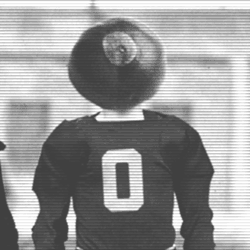We covered the recruiting angles in our last two posts, so let's move on to prong two of my reasoning as to why Ohio State isn't a blue blood yet: coaching.
Again, a preface: I have quibbles with some of Coach Myers decisions and tactics, but there's a reason he's the winningest coach in OSU history. Coach Myers is a great coach, and has done everything he could do to make Ohio State better. The choices made have been dictated by a variety of factors, mostly out of necessity, but this is internet speculation 101, so I have points to make about the effects of these decisions.
And, naturally, why I disagree with some of them. It’ll all be over soon, so don’t fret. We’ll move on to other, more interesting topics after this.
First and foremost, I will start positive. Coach Myers has brought winning lacrosse to Columbus. Full stop. He is already the winningest coach in program history, will almost certainly retire in Columbus if he doesn’t get lured away by another school, and has laid the foundation for a special program at Ohio State.
The premise of this has been that Ohio State isn’t a blueblood lacrosse power yet, but Coach Myers has done more than anyone else to prime the pump for the Buckeyes to reach that tier. He’s done so by making the Buckeyes a defensive powerhouse most years, and without a doubt that’s the underlying reason for so much of Ohio State’s success.
The issue is that Ohio State has been woefully underpowered offensively. Yes, there have been some special lacrosse players to suit up in the Scarlet and Gray. Jesse King, Eric Fannell, Logan Schuss, Jack Jasinski, and Tre Leclaire are some incredible players. The offense as a whole, however, hasn’t been good. Let alone at a championship caliber.
They’ve fallen short on shots, shots on goal, SOG%, and goals (obviously), in such a way as to make the 2017 run a once-in-a-lifetime experience. I’ll cover the data first, then the reasons for the data, before we end on a hopeful note.
From a statistical perspective, no Ohio State offense of the last four seasons (I’m including 2020 for illustrative purposes only right now) has been of a championship caliber. The 2017 team was the closest, but had some serious issues that resulted in their paltry 6 goal output against a tremendous Maryland team.
That game shouldn’t have been as close as it was, but the defense for Ohio State was so good that year it kept them in it. On average, every Division 1 champion from the past 11 years has scored 258 goals in 19 games (also on average). They’ve done so on 782 shots, with 482 of those being on goal.
The resulting SOG% has been 61%, on average. Breaking things down further, championship offenses score a little over 13 goals per game, take 40 shots per game, and outshoot their opponents by 7.5 shots per game. These offenses generally also have nearly 3 more assisted goals than their opponents per game (2.68).
In no full season after 2016 has Ohio State come close to any of these numbers. The 2017 team had 21 games, but still failed to get to that 258 goal number (238).
In 2018, Ohio State didn’t even average 9 goals per game (8.93), while in 2019 Ohio State was on pace to score just a handful of goals more than that 2017 with a much worse defense (11.75 in 2019 to 11.33 in 2017).
For reference, no team has ever scored fewer than 12 goals per game in the past 11 years and won a title (2012 Loyola scored 12.05). Ohio State has been outshot each game, on average, 2 out of the last 4 seasons, including 2020 (albeit barely at -0.2 shots per game). At no point in the last 4 seasons (2020 included) has Ohio State averaged that magic 40 shots per game number.
The title-winning team with the lowest number of shots per game was actually the 2017 Maryland team Ohio State lost to, with 35.9. Maryland averaged over 4 shots more per game than their opponents that season, however.
Ohio State also was nearly 60 shots below that 782 number I mentioned earlier in 2017, despite having two additional games played. Shots on goal were similarly paltry, although Ohio State has been right on the pace for SOG% each of the last 4 years, actually increasing their 2020 SOG% nearly a full point.
In short, after this tremendous dump of information and data, the coaching staff hasn’t been nearly good enough offensively to truly compete for a Final Four berth, let alone a national title. Without titles, or annual Final Fours, Ohio State won’t gain any prestige or cachet on a national stage.
I talked about the numbers, now let’s talk about scheme. I will do my best to not lose the casual reader as we go.
Obviously, from my notes above, we can tell that 2017 was a special year offensively for Ohio State. And it was a banner year, given the dearth of offense in years prior and following that run. Coach Myers’ teams have hung their hats on defense, and it shows. Prior to the stall warning, watching Ohio State play offense was dreadful.
Dodges went down the alley, the ball spun around through X (behind the cage) to another dodger on the right side of the field (looking towards the mouth of goal), and things just kind of repeated themselves. On occasion, Ohio State would get lucky and a dodger might beat his man, but this was (and still is) rare.
Even the stall, and now the shot clock, hasn’t done enough to spur the offense to action. In 2018 and 2019, only Jack Jasinski was capable of running past someone on the outside. Whether he dodged down the alley, or made a sweep across the top, Jasinski was almost instantly double-teamed.
When the extra man came, Jasinski was hard-pressed to get the ball out of his stick. Most of the time, Jasinski’s dodges weren’t set up to take advantage of Tre Leclaire’s talents. Instead of having Leclaire adjacent to the dodge, setting a pick, or directly opposite of Jasinski’s path, Leclaire would be wasted in no man’s land.
Leclaire would be below GLE, making his cannon useless since you can’t score from behind the net, or Leclaire would be too far away on an adjacent path to make use of a compressed defense. Other dodgers, with less skill than Jasinski, would find themselves unable to beat their man, then dump off the ball to a teammate who was already covered by a waiting defender.
Off-ball, while these ineffective dodges occurred, players would be standing still, watching the play, offering no threat to the defense. I watched 2018 and 2019 apoplectic, staring at players who did more watching than playing in the offensive zone.
It was dreadful. And it certainly didn’t lead to the sort of scoring offense that is needed to win games against the best. Or even the mediocre (Rutgers, TTUN). Dodging to nowhere, a complete lack of off-ball movement, no real two-man game to speak of, all of these things should be corrected by coaching.
Recruiting guys who can actually beat a guy has been covered in parts 1 and 2 of this series. Bottom line, the coaching staff as a whole didn’t utilize the pieces they had well enough in 2017, 2018, and 2019, along with prior seasons, to make the team a threat offensively.
The unit has not been good enough for years to win double-digit games regularly, or put up much of a fight against the upper echelon of the lacrosse world. This, in turn, leads to poor recruiting of offensive players, causing the coaching issues to not be covered up by superior talent, resulting in a vicious cycle of bad offensive output.
Really, then, why isn’t Ohio State further along nationally? Because the team has been too poor offensively to leave a lasting mark. Essentially, they’re the Baltimore Ravens of college lacrosse, without conference or national titles (in the Big Ten).
Having castigated the offense, and the staff, enough, let’s look at 2020. Because there’s some rays of sunshine amongst all my mudslinging. In 2020, the offense took a huge step forward. And I mean HUGE. Part of this was the incredible lineup at attack this year’s team had with Tre Leclaire, Jack Myers, and Jackson Reid.
As a group, however, the offense was on pace for 262 goals (over 19 games). That’s a championship-level team no matter how you slice it. The offense, despite a putrid game against UMass, was averaging nearly 39 shots per game. Ohio State increased it’s already impressive SOG% to 61% even, a fantastic achievement.
And the Buckeyes were on pace to shatter their 2017 assist mark of 117, in line for 170(!) assists over a 19 game season. That’s an assist % of 65%, which is unheard of, and would have given the Buckeyes the 2nd-highest assist margin (3.57 per game) of title-winning teams in the past 11 years.
Only 2014 Duke’s assist margin was higher at 3.75. As a note, assist margin is the difference between a team’s assists and all opponent assists, divided by the number of games.
I.e. Ohio State had 3.57 more assists per game in 2020 than their opponents through 7 games. Additionally, thanks to an insane performance against Notre Dame, Ohio State finally got their Man Up totals to a title-winning level, converting 46% on the year. That’s really, really good.
And, frankly, that’s without true game-breaking midfielders on the offensive end. There are definitely some quality prospects, but no Buckeye offensive middie was going to be an All-American this year. Griffin Hughes was on pace for 33 goals and 43 points this season, but most likely would have been an Honorable Mention.
In any case, I can tell you with certainty things will only get better from here as there are some tremendous players coming in with the next two classes at offensive middie. And some serious finishers.
The coaching hasn’t been up to snuff through 2019 on the offensive end, but I can tell you with facts it’s gotten better already thanks to Coach Myers bringing in Coach Sheridan, and as more talent fills the ranks, we’re in for a special ride, hopefully to a few Big Ten titles and a national championship ring or two. At the very least. And I’m hoping to be writing a lot of mea culpas on here very soon.
Go Bucks!

